There’s a concept relating to electric cars that I think makes a lot of sense — a concept that I’ve discussed, and one that non-idiots, like automotive designer Henrik Fisker, have discussed. The concept is that when it comes to EVs, which all generally have the same set of driving characteristics thanks to the nature of electric motors – great torque from the get-go, smoothness, silence, no jerks from shifting and so on – the other characteristics of a car, especially styling, become increasingly important. The new 2024 Hyundai Ioniq 6 is a great demonstration of this concept. It’s an EV that stands out less for the way that it drives and more because of traits like striking styling, a cool user interface and experience, and clever space utilization. Sure, there’s plenty of other important traits, but overall I think the Ioniq 6 is a great case study in an automaker doing a good job of paying attention to what seem to be the qualities of a car that are important to lots of people, and then, you know, building that car. So let’s talk about “that car.”
Actually, if you’d prefer a short sorta-synopsis on video, I have you covered, too:
How To Evaluate An Electric Car Like This
Well, perhaps before we dive into the specifics of the Ioniq 6, let’s look at exactly what Fisker had to say about EVs, because, again, I think it’s very relevant here:
“Design is going to be increasingly important. When you move to electric vehicles, you’re not interacting anymore with a complex mechanical gasoline engine where the engine noise and response varies extremely from different car companies. So I think values from buyers in the future are going to shift.
“We’re all going to expect fast acceleration, instant torque that we have in acceleration – but we’re going to start looking at other ways to entice the buyer. Exterior and interior design. The user interface. The ride and handling.”
I’d add to this the all-important range number and the state of the recharging network available to the car. Oh, and space utilization and practicality. But, old Henrik is right: styling is incredibly important, because humans really, really care about the way things look. That’s why we have fashion and architecture and industrial design instead of just massively efficient factories churning out generic jumpsuits that we wear in our purely rectangular poured concrete buildings as we choke down nutrient bars that taste like unsalted drywall. We’re not coldly rational beings, we never will be, and I’m just fine with that.

This is the mindset I think we need to have when thinking about EVs like the Ioniq 6: The intangible and irrational qualities are extremely important, and we have to respect those, because we are intangible and irrational ourselves. Of course, cold, uncaring reality is still something we need to deal with, so don’t think I’m just ignoring all of that. With this in mind, I came away from my time with the Ioniq 6 feeling pretty good about the car. It’s not without its flaws, of course, but it’s also a pleasing object to interact with, a space to exist in, and a tool to use.

[Full Disclosure: Hyundai flew me out to Arizona and put me up in a hotel that smelled like rich people. The company fed me several times, plied me with alcohol, pretended to tolerate me as a person, and gave me access to engineers and designers. They also never did that thing where one person crouches down behind you while another person shoves you backwards, even though they had ample opportunities to do so. – JT]
The Ioniq 6 starts at $41,600 for the 149 horsepower, 240-mile range base RWD model, and can also be equipped as a RWD 225 hp model with 361 miles of range, or as a dual motor AWD sedan making 320 hp, topping out at over $52,000. We’ll go over all of this later, but let’s dig into my driving experience as much as we can first.
How The Car Looks In-Person

I’m going to talk about the design of the Ioniq 6 first because I think this is one of those cars where the styling is an extremely significant trait, because it’s distinctive and, sure, pretty polarizing. In fact, when I wrote about how the styling was at least partially inspired by the legendary Art Deco rear-engined bread loaf known as the Stout Scarab, I’ll admit I was surprised to find a large number of negative comments from our readers regarding the Ioniq 6’s design.
I like the look a great deal, but it’s clear that it’s not everyone’s fistful of chili. In part, I think that’s why I like it: It’s not boring. It’s an unexpectedly busy design, especially from certain angles like the rear three-quarter view, but again, I think that adds to its appeal. A lot of modern design elevates and idolizes ideas of purity of form and cleanliness, but the truth is sometimes having many things on which to focus can help give a car character.
I tend to think that’s at least partially why classic cars, with their large and varied congregations of chrome trim and horn grilles and stuck-on lighting units and creases and fins and vents and whatever, they tend to be things we can relate to emotionally — more so than the smoother, more integrated and more featureless forms that make up so many modern designs.
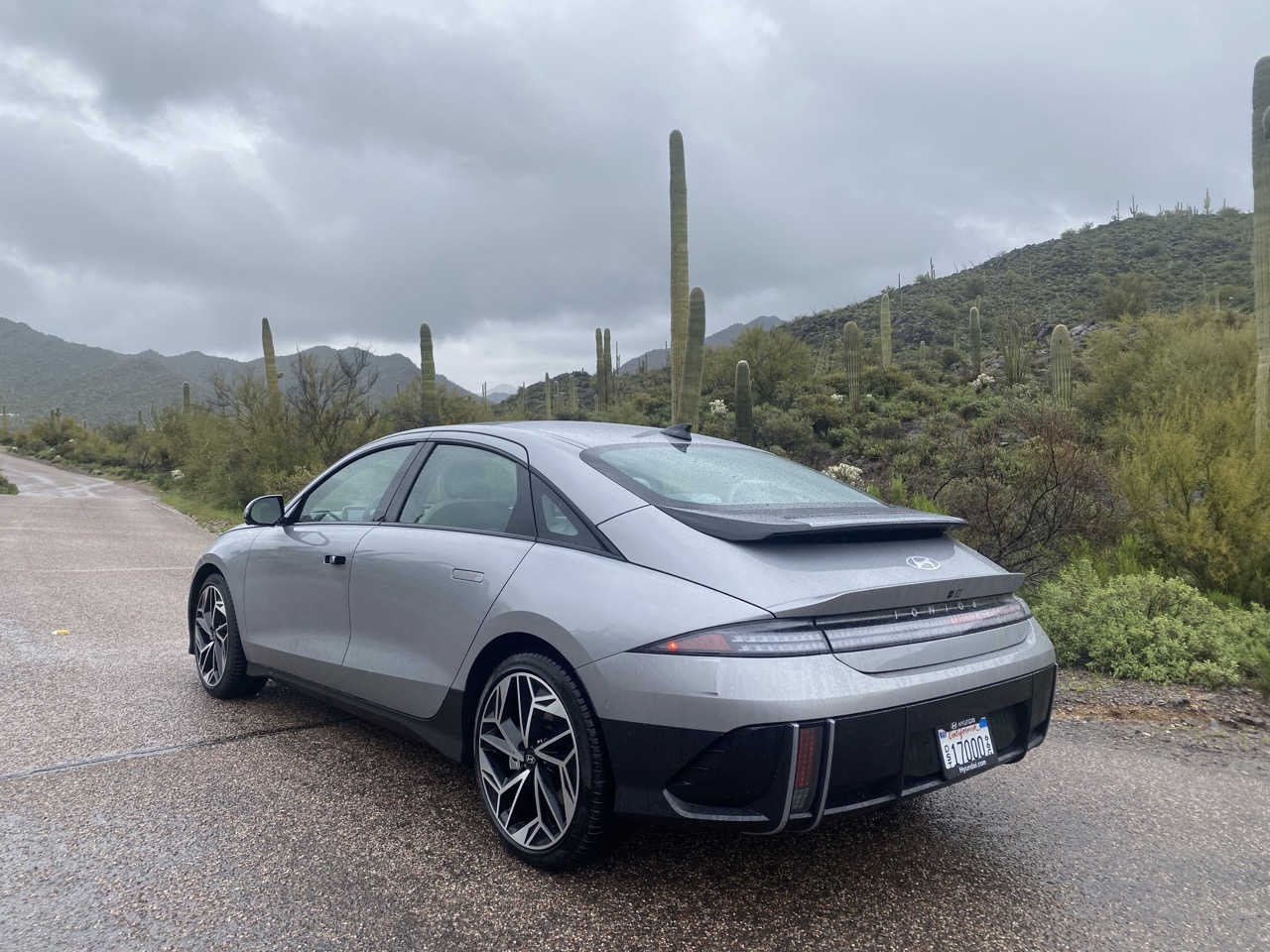
Just look at this angle of the Ioniq 6 here; there’s a hell of a lot going on. This is a car not afraid of its own shutlines and panel lines, and wears them almost like some kinds of geometric tattoos. The panel shapes and cutlines are carefully considered, like the one that continues the line of the wraparound heckblende taillight and continues into the wheelarch, dividing the rear quarter panel from the upper bumper skin. The bumper area has a lot going on, too, like the pair of vertical bumper guard-like units on either side that house the rear retroreflectors and reverse lamps. I can’t think of another modern car that has a bumper feature quite like this.
The rear is rounded, and perhaps even a bit droopy, reminding me, as I mentioned before, of the old Infiniti J30’s hindquarters:

This sort of rounded shape, popular in the early 2000s (think Audi TT, also) demands a spoiler to help keep it planted at speed, and where on older designs of this type those spoilers tended to look like tacked-on afterthoughts, it’s integrated well here. In fact, there’s that spoiler below and then a sort of wing above, incorporating the large third brake lamp and making the Ioniq 6 one of the few cars to come with dual rear spoilers/wings from the factory, like the Merkur XR4Ti:

I don’t think Hyundai was trying to pay homage to everyone’s favorite fancier Ford Sierra; I think the brand made these choices in order to get the best possible aerodynamic results that it could, and the team seems to have achieved that, with a drag coefficient of 0.21 — one of the best of any car currently built, and better than, say, the Tesla Model 3, which has a Cd of 0.23. That’s also why the car features some peculiar-seeming surface details, like this odd little sculpted rectilinear lump within and below the taillight:

That’s an aero enabler, directing the wind away from the body at the rear of the car, which helps because of some aerodynamic explanation that has so much math in it that were you to try to explain it to me, I’m pretty sure a lone trickle of blood would drip out of my ear before my head fell heavily to the table, never to rise again.
Crap, now that I look at that little section I can’t not see, of all things, some Chevy Monza in there:

I mean, I always like the rear end of the Monza, so I can’t feel too bad about that. I just wasn’t expecting it.
I say all this because I want to be clear that the design of this car is not frivolous; there are aerodynamic reasons for much of it, but there is also a very clear design theme at work, playing a lot with the tension between the curvilinear large overarching forms and the smaller geometric details, which seem to be inspired by Hyundai’s Parametric Pixel design language. Here, look at some of the details in the lighting and other places:



Grids, squares, pixels, whatever you call them. It reminds me of not just pixel art but also the sort of detailing seen in the Postmodern movement, like the postmodern architectural icon Michael Graves’ 1982 Portland Building:
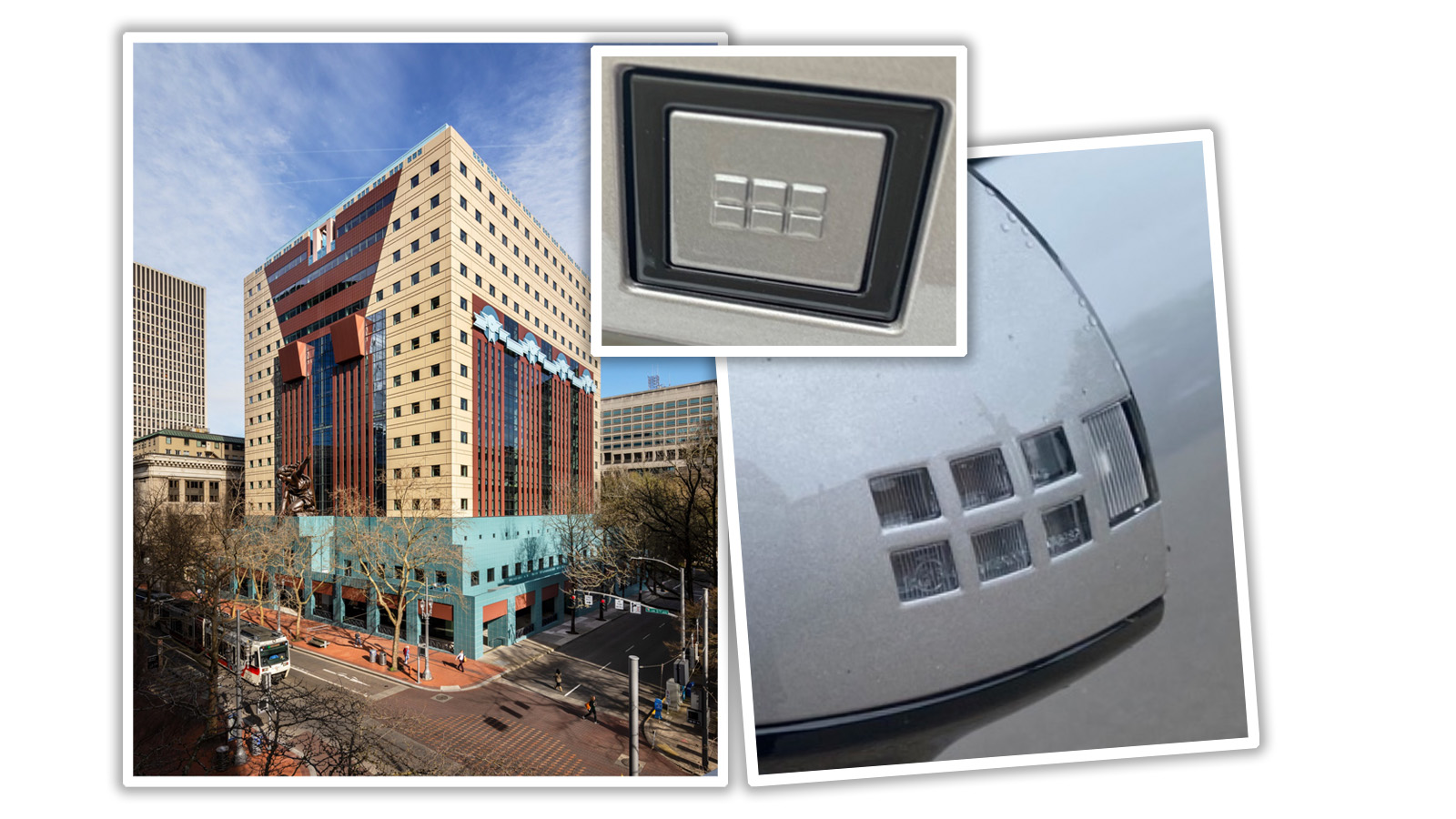
It’s probably also worth noting that this building is really controversial in the architecture world, with plenty of snobby architecture critics absolutely hating it. Plenty of people like it, too, so I think in that sense the Ioniq 6 feels like a distant relative.

Around front, the grille-less (there actually are air intakes under the front bumper there, hidden by the two panels to the left and right of those central six squares; yes, those panels are active shutters that open and close as needed) front end really evokes Porsches, though Hyundai design lead Hak Soo Ha insists that Porsches were not a design inspiration. I like the clean front end; it’s so much simpler than the rear, yet still not looking out of place.
In profile, I think the Ioniq 6 has some real presence. It looks sleek and not exactly futuristic, but almost retro-futuristic, like how we’d have imagined the future at some indeterminate time in the past:
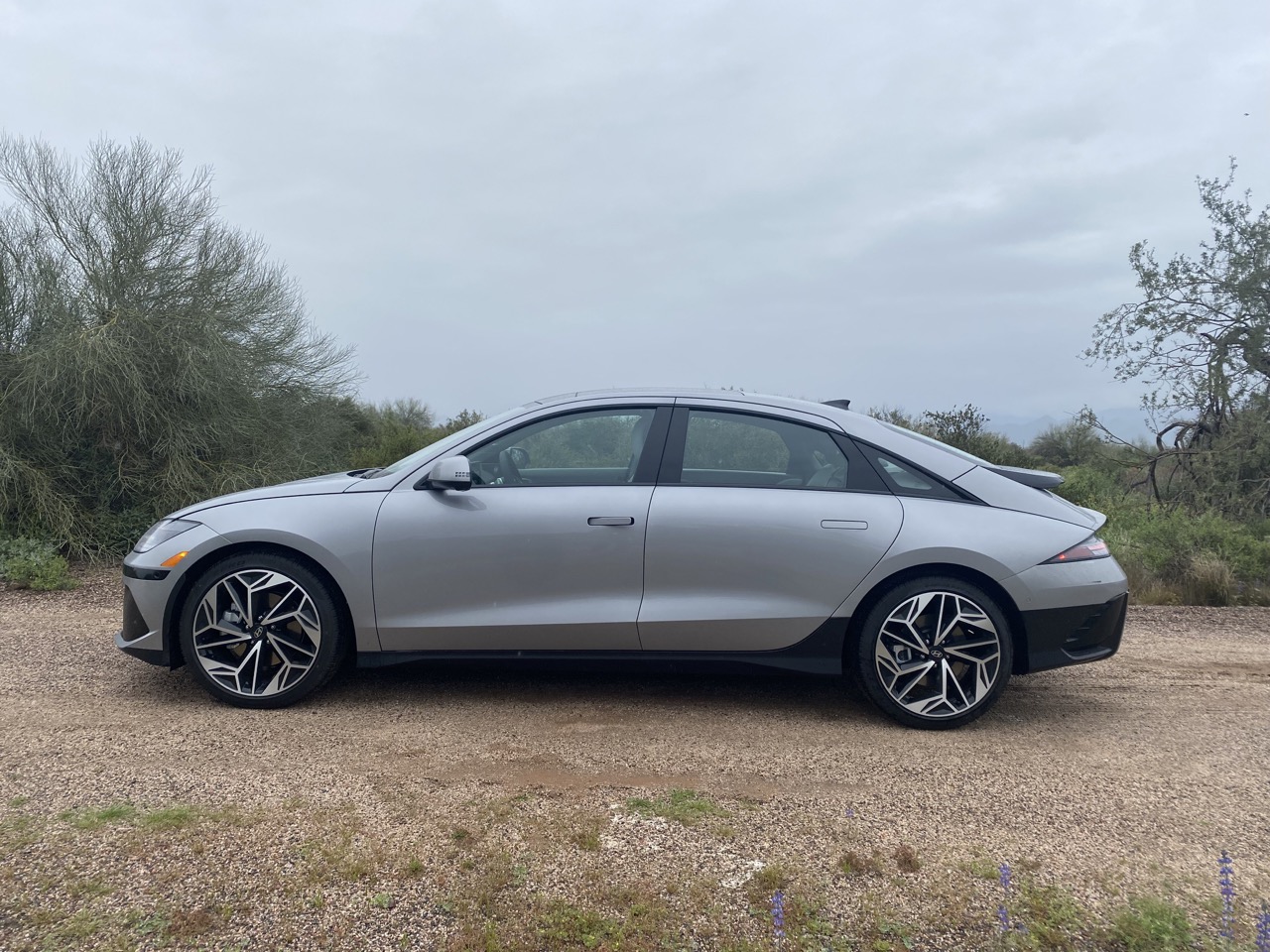
The challenge of designing an EV sedan as opposed to a crossover or SUV is that the nature of most EV platforms is that they are “skateboard”-like designs with the batteries built into the floor, which makes a very flexible and potentially space-efficient platform, but also one that has a relatively high floor height. This isn’t so much of a big deal for a crossover or SUV, but for a sedan that you’d like to be low and sleek, it’s tricky.
Hyundai pulled it off quite well, I think, and as a result the Ioniq 6 is taller than it looks, a nice bit of visual trickery. The lower black areas of the body help reduce the visual height, as does that curved inset character line, and I think the choice to let the rear door remain just body colored and cut into the black area is interesting.
It seems the there’s a way to get the Ioniq 6 with a sort of inverted color scheme, as I saw a black car that had light gray in place of the black lower areas, and it looked pretty striking:

I like those wheels, too, like a gleaming silver pizza flying apart. I’m glad Hyundai has this option for black cars, otherwise all the details would get swallowed up by darkness. Speaking of color, Hyundai seems to be doing a bit better than most of this chromatically cowardly industry, having at least three actual colors – a blue, red, and even a green – along with the usual white, silver, and black. Oh, and there’s a gold, too:

The Ioniq 6 will not get lost in your average Target parking lot. People will notice it. People will see it and their eyes will track it as you drive by, and opinions will form in their heads. They won’t all be positive opinions, but they won’t be boring ones, and I feel that’s high praise for an automobile.
Oh, you know what’s kind of a fun and odd little detail? This:

That’s the car’s antennae fin, on the roof, but the housing is transparent so you can see all the components inside. Neat!
Oh, while we’re on the roof already, I do think the glass roof area could have been larger. There are so many nearly-full glass roof options out there today, after all.

Anyway, let’s move into the cabin.
What I Thought Of The Interior

I liked the Ioniq 6’s interior a lot. It’s clear that Hyundai expended serious effort to really maximize the interior volume here, and I think the team accomplished that very well, as the car feels roomy front and rear, with plenty of legroom and headroom. Being someone with a body that demands little of either of those, I understand if you may be skeptical, but I witnessed normal-sized and even larger-sized humans sitting in and getting in and out of the front and rear and they looked to have plenty of room, too.

Like most modern EVs, the rear floor is totally flat, too. You want numbers? Fine, let me find that slide:

I apologize for the moire pattern but at the same time, it’s kind of pretty, so I don’t feel too badly. As you can see, the Ioniq 6 has best-in-class rear leg room, and front leg room about the same as the Tesla Model 3 and Polestar 2. Front and rear shoulder room are also excellent (a less considered metric but one I feel contributes to a cabin’s sense of roominess) and the overall passenger volume, at 103 cubic feet, is higher than either the Tesla or Polestar. I suspect this overall cabin space was the main target of the design team, because it feels like that’s where most of the effort was put in.

The trunk isn’t the biggest at 11.2 cubic feet, but it’s pretty roomy and certainly usable, and the rear seat has a 60/40 split fold-down that should make it possible to carry your expected six-foot party subs or javelins or both, depending on what sort of parties you frequent. You may have noted that there is “front storage” listed on that chart, and you may have noted that the Ioniq 6’s volume there, at just half a cubic foot, is pretty tiny, and I do have something to say about that.
First, I want to be clear that I applaud Hyundai, vigorously and loudly, for giving any front trunk space at all. There are plenty of other EV makers, especially from Germany, for some reason, that seem to be loath to carve out some cargo area under the front hood, even if they have empty volumes of space just sitting there. I think the fact that Hyundai has made a well-finished little front trunk area is admirable, but I have one gripe. You see, on the dual-motor Ioniq 6, the front trunk is small because there’s simply less volume available, because there’s a motor unit there. Okay, fair enough.
That’s part of why if we compare the dual-motor Ioniq 6 front trunk with the one in a Tesla Model 3, the Ioniq 6’s trunk seems so puny:
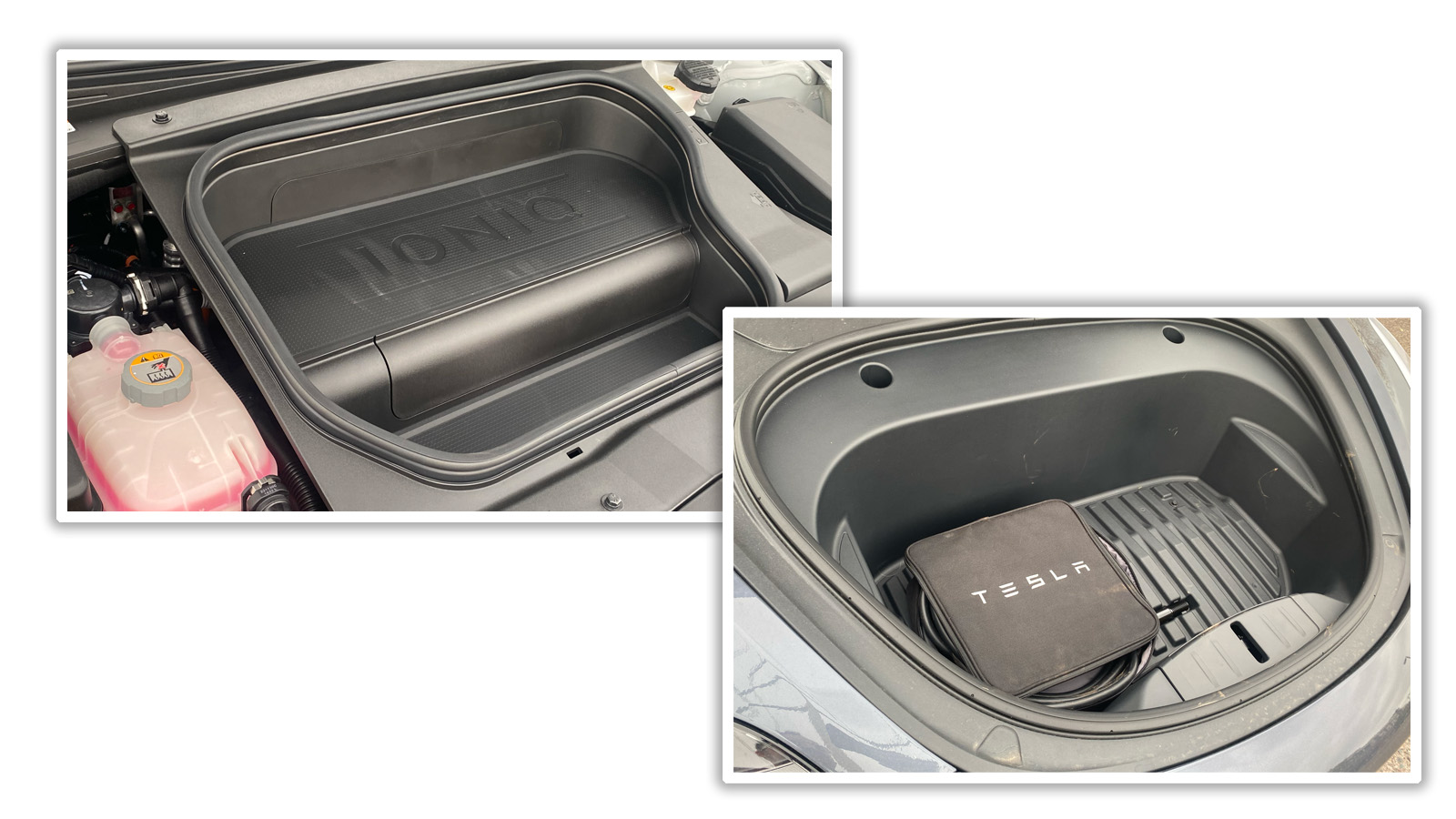
But, of course, in this case, the comparison isn’t totally fair, because that Tesla frunk up there is from the single-motor car, and as such has more volume to play with. What about the single-motor Ioniq 6? Shouldn’t that be able to carve out more frunk room?
Well, the answer is yes, but, maddeningly, only if you don’t live in America. For some inane reason – I think maybe that regulation designed to keep kids from somehow getting crammed in trunks – both the single- and dual-motor Ioniq 6s have the same shallow trunk for U.S. market cars, while global market cars enjoy a much deeper front trunk. Look, I found a picture and everything!
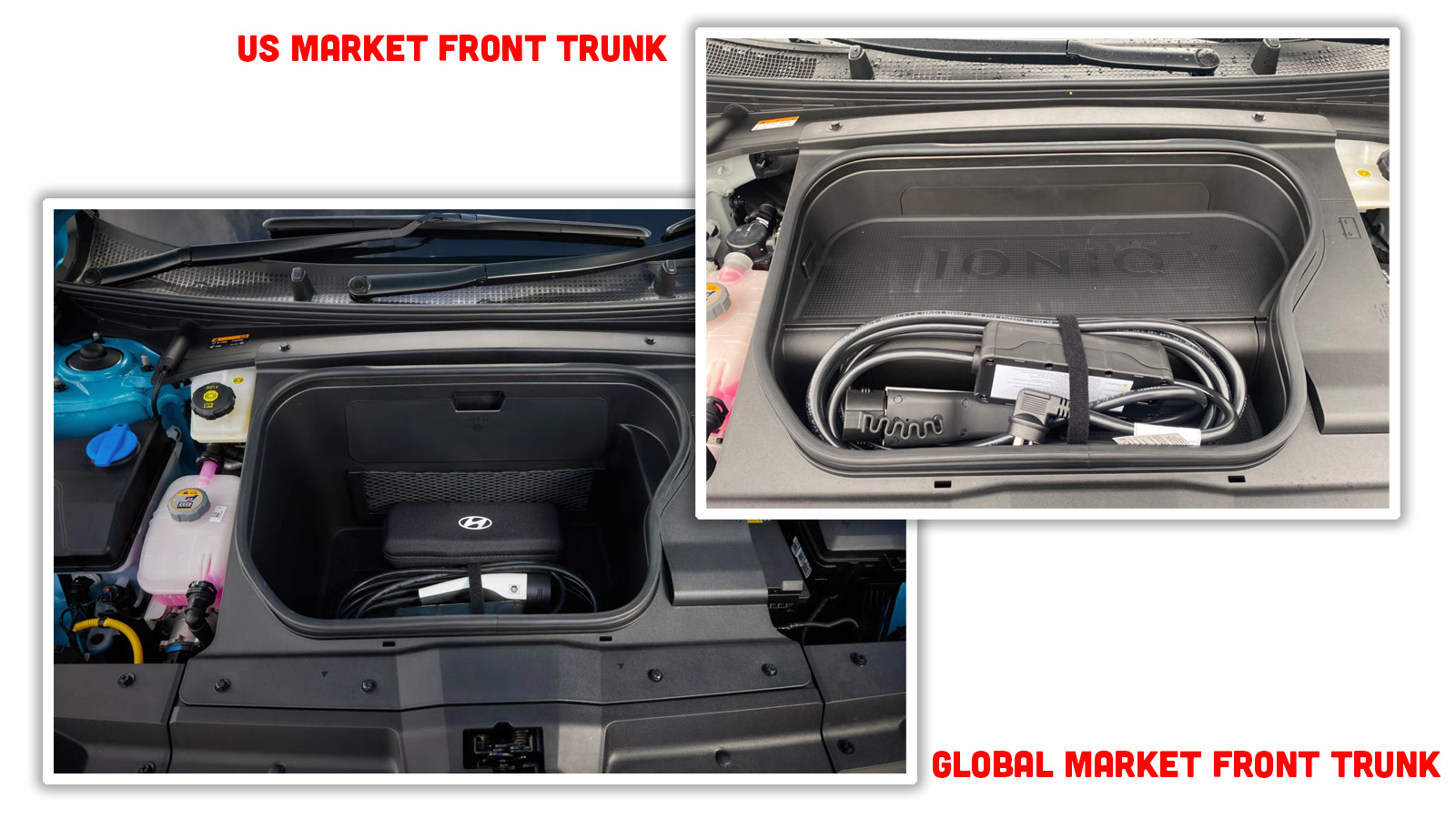
Look at that! It’s like over twice the volume of the one we get! This is a crime! A crime, I tell you! Can’t they just shove in a removable anti-toddler divider like all those supercar makers use? Come on, Hyundai.
The interior materials are interesting; a lot of it uses what seems to be a recycled plastic with a textured surface that resembles a textile like canvas or linen. It’s a kind of material that, while not necessarily overtly “premium,” is one I’ve come to associate with some types of interesting low-volume arty objects I’ve encountered over time, and so I have a set of positive associations with how it looks and feels.

My driving partner didn’t agree, and didn’t like the material. This may be one of those tactile things that you’d have to decide for yourself; whatever you think of it, it seems durable and hard-wearing, so that’s a plus. That double-decker center console is interesting because I was told by a designer that those side “rails” are designed to be higher than what’s between them so you can set a laptop across the top, using it like a desk.
What is in between them is something that I’m less fond of: the window controls.

If you’re not going to put the window controls on the doors, there should be a damn good reason, like you can take the doors off or you have a manual shifter that the driver’s hand is near, anyway. Otherwise, it just feels wrong. My fingers kept fumbling around on the armrest for buttons that were not there. I suppose you could get used to it, but why should you, dammit?
Well, since we’re on the subject of switches, I guess we can go ahead and jump right into this:
Interior Gadgetry
You know what may be the most interesting thing that’s not on the dash of the Ioniq 6? It’s what would have gone here:

See that odd little wing/wall thing on the side of the dash, with that big flat plastic panel on it? It’s an interesting looking design choice for the sides of the dash, isn’t it? That’s because it was intended to be something else; specifically the place where the screens for Hyundai’s Digital Side Mirrors would go:
Clever visibility anytime with the “Digital Side Mirror” of the new IONIQ 6. The cameras and OLED displays integrated with the dashboard offer a clearer, wider view than conventional side mirrors.#IONIQ6 #ElectrifiedStreamliner #AwakenYourWorld #Streamliner #EV #Hyundai #IONIQ pic.twitter.com/yDKKBYfp5I
— Hyundai Worldwide (@Hyundai_Global) August 16, 2022
Camera-based side mirrors are not legal in America currently, so where the rest of the world has little camera-based side mirrors, we have old-school mirrors. While this does cost the US-spec model a bit of an aero hit (0.22 Cd instead of 0.21), personally I’m glad we don’t have them for two reasons: one, I don’t think screen-based mirrors work as well as physical mirrors (I’ve addressed this before) and, also, there’s just something about adding the complexity of an electronic component like a camera to replace a dumb, cheap mirror that does the same job without power or anything that rubs me the wrong way. Sure, there are aero advantages, but do those compensate for the power draw of the cameras and screens? Maybe? I don’t know. Anyway, we don’t get those here, so find a sticker you like for that little gray slab.

The instrument cluster is, as you no doubt expect by now, an LCD screen, of about the same size and aspect ratio as the center infotainment screen. Both are large and bright and very high quality, but Hyundai doesn’t expect you to do everything on the screens, which I appreciate. There’s a physical volume knob and physical and separate touch climate/HVAC controls.
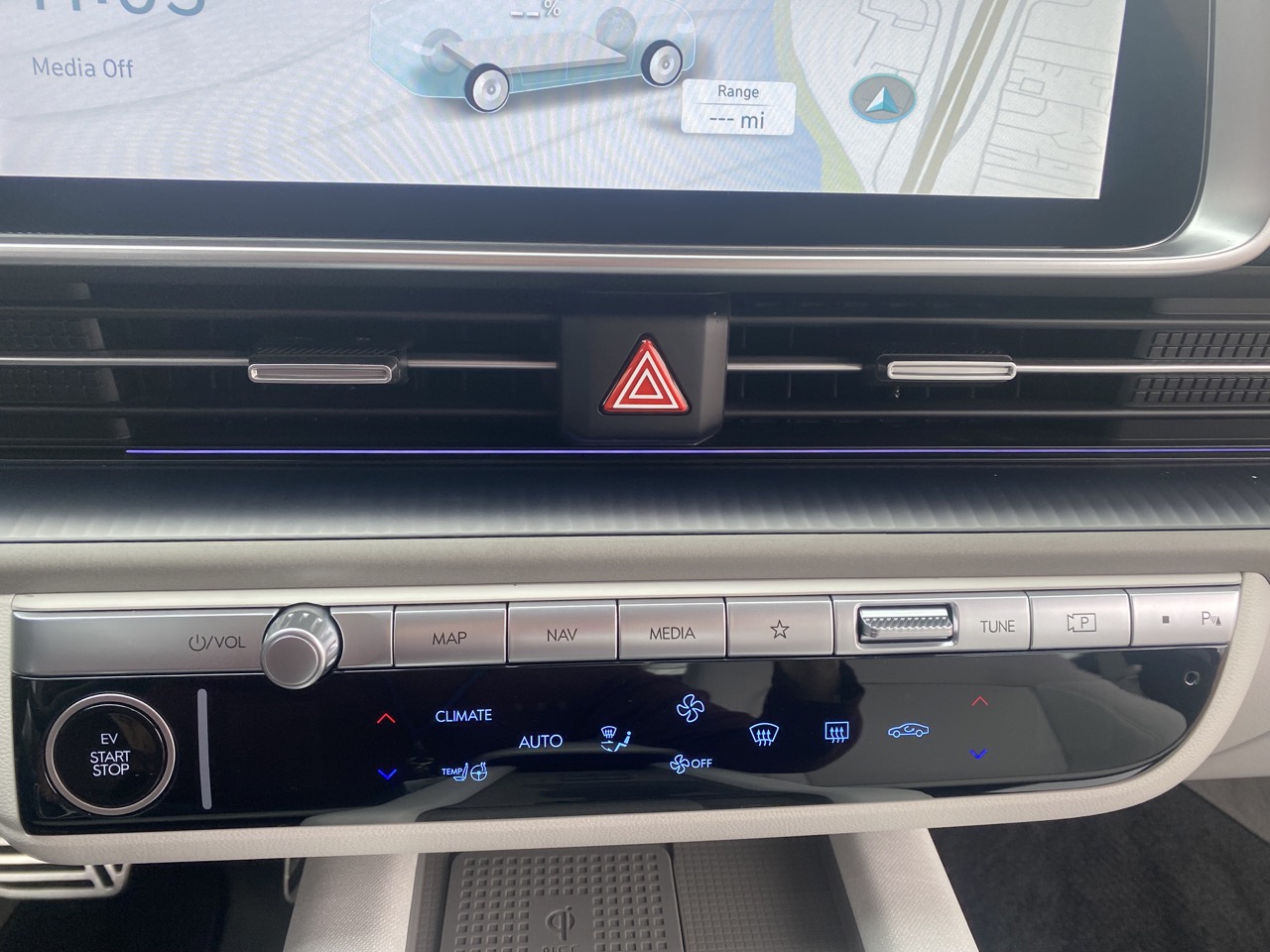
I may have wanted more tactile HVAC controls, but at least these are always present and in the same, expected place. They worked well and in obvious ways, which is what you really want out of something like your climate controls. There’s a little row of other commonly-used functions on physical buttons, and the vents use simple and expected physical sliders to direct the air or to close/open them. Good. This just works. There’s no good reason to navigate an on-screen menu to be able to blow cold air on your crotch in the summer.

The shifter is a column-mounted stalk, but not quite like the one on your old Pontiac Bonneville; you pick which direction you want to travel by rotating the end there. It works, and it’s nicely out of the way.

Hyundai’s designers also made a big deal about how they eliminated the company’s badge from the steering wheel center, since you probably know what you’re driving already. They replaced a logo with four lights (four dots is also “H” in Morse code, so there’s an Easter Egg) and those lights give the driver a bit of information, such as when the car is using assistance like dynamic cruise or lane keeping, as well as indicating charging status when plugged in. I like it.
Moving on, do you know what Hyundai/Kia does better than almost anyone else? Wiper controls. Look:

When you move the stalk, you get this little pop-up window that tells you what your wiper setting is. Most cars just rely on you knowing which notch you’ve set the stalk to, which is often hard to tell. Why doesn’t everyone do it like this? It’s great.

The interface design for the instrument cluster is pretty legible, even if the 3D, receding-into-the-dash bar graphs laid out like an open book feels a bit arbitrary. The speed and range are clearly visible at a glance, so that’s good, at least. The instruments change look based on the driving modes, Eco, Normal, and Sport. Here’s Sport, which turns the highlight color a more lusty red:

You can also use Apple Car Play or Android Auto as an alternate infotainment system, unlike Teslas or possibly some other brands in the near future. It is, however, only available when the phone is physically plugged into the USB port via a cable, not Bluetooth. One day I need to sit down and figure out why some carmakers are able to connect to Car Play or Android Auto wirelessly and some aren’t, or don’t.

Oh, and our podcast will be starting again soon, just so you know.
Oh, and speaking of weird sounds that can come out of your car, the Ioniq 6 does make replacement noises for the lack of engine sounds while driving, and they’re generally Jetsonian and inoffensive, providing a nice bit of audible feedback when you accelerate. There is also ambient lighting that can change while you drive, but I didn’t really get a chance to drive the car in darkness, so I can’t tell you if that’s a fun experience or not. I mean, it sounds kinda fun?
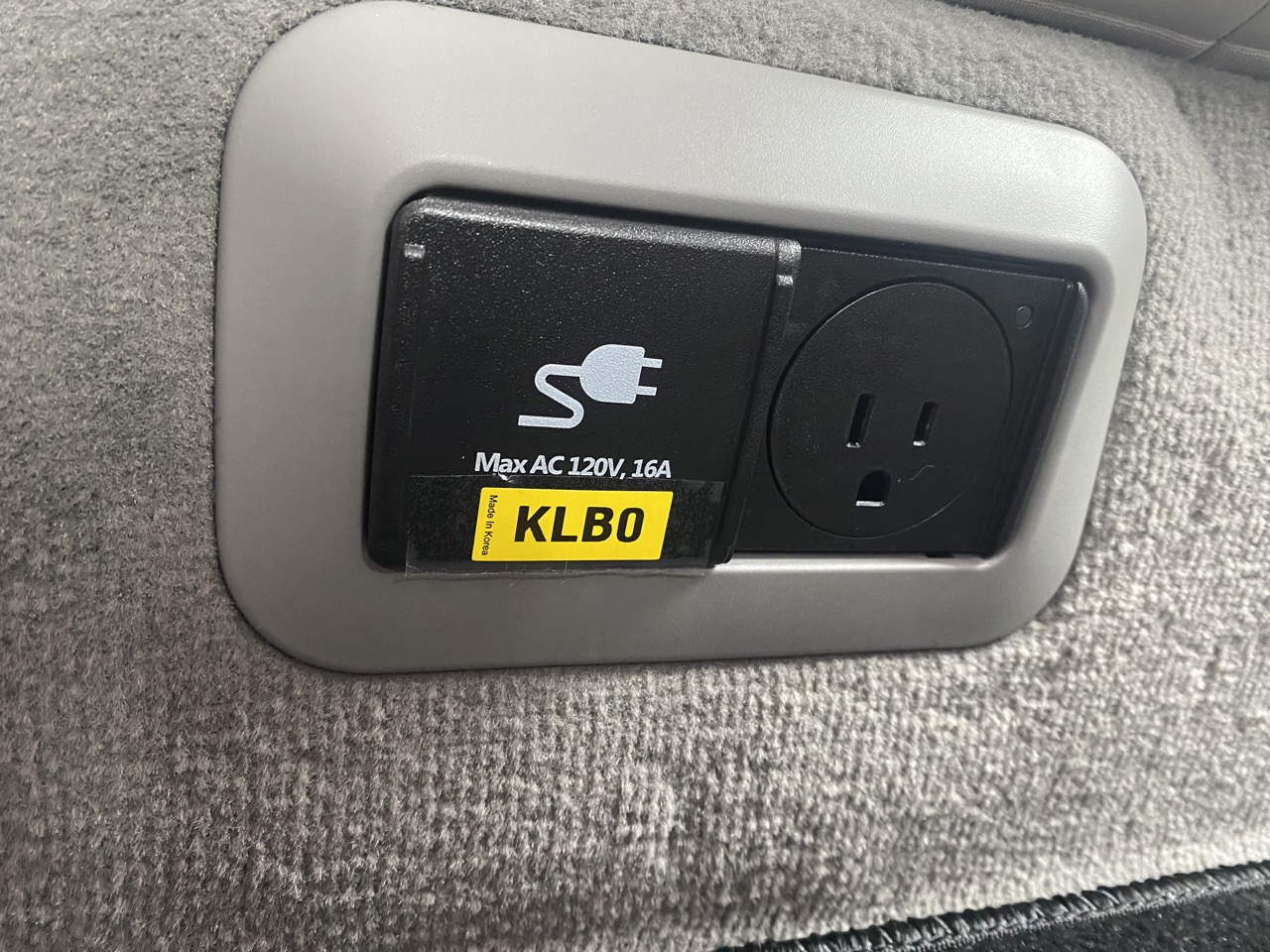
In addition to the expected USB A and C ports in the car, there’s also a 120V wall-type outlet under the back seat that can be used for, well, most stuff you plug in. A toaster, maybe. A Vitamix. A massager. I was told by one of the engineers that his team (briefly) ran a welder off the socket! And also a refrigerator for five days, with, they claimed, minimal drain on the battery.
What It’s Like To Drive The Hyundai Ioniq 6
I suppose were you to hold me at knifepoint and demand that I pick one word to describe the driving experience of the Ioniq 6, my first reaction would be to be gravely concerned about your mental state and perhaps suggest you seek out therapy or the counsel of a trusted clergyperson. Were you to persist, I think I’d pick the word “pleasant,” because, well, it generally is a pleasant experience.
It’s an easy car to drive; the suspension feels more tuned for comfort than outright performance, and compared to what is arguably the Ioniq 6’s biggest competitor, the Tesla Model 3, it’s not as quick and has a softer, less harsh ride. It’s less performance-oriented, and for most of the people likely to buy one of these, that’s probably fine.

That’s not to say that it’s not quick; in Sport mode, electro-throttle response changes dramatically, and the Ioniq 6 pulls hard and feels genuinely quick. Not Tesla Model 3 quick, but still pretty damn good. It’s really easy and comfortable to drive at highway speeds, and would make an ideal road trip car were it not for one huge issue that’s not really the fault of the car itself: the lack of a truly reliable and widespread charging network.
That’s really the biggest advantage of a Tesla in this context; its Supercharger network is quite well established and generally a known quantity. Sure, Hyundai’s Electric-Global Modular Platform (E-GMP) allows for 800 volt, 350 kW charging that can go from 10 to 80% charge in 18 minutes — a fantastic achievement — but only if you can find a charger that can accommodate those kinds of speeds.

(As an aside, I think most EV-makers are using some fun little symbols on their EV pedals now. This time it’s not play/pause, it’s + and -. Maybe we’ll get the hand for stop and a walking guy next?)
Currently (crap, is that a pun?) Hyundai is partnered with Electrify America, and their network isn’t as robust as Tesla’s, both in number of stations as well as the maintenance and reliability of those stations. The Ioniq 6 will pre-heat and prepare the battery for optimal charging when it knows you’re on the way to a charge station, but this only helps if you can find a properly equipped station to use.
If you’re charging primarily at home every night, this is less of an issue, but Hyundai has built a car here that’s roomy and quiet and comfortable and has an impressively long battery range (361 miles for the longest rated version) and by almost every metric would be a terrific long-haul cruiser – if you know you can easily find a place to charge it on your road trip.
I’m hopeful the charging network will continue to improve. While we’re waiting for that to happen, I can tell you about what I think is the Ioniq 6’s most novel driving feature: its paddle shifters.
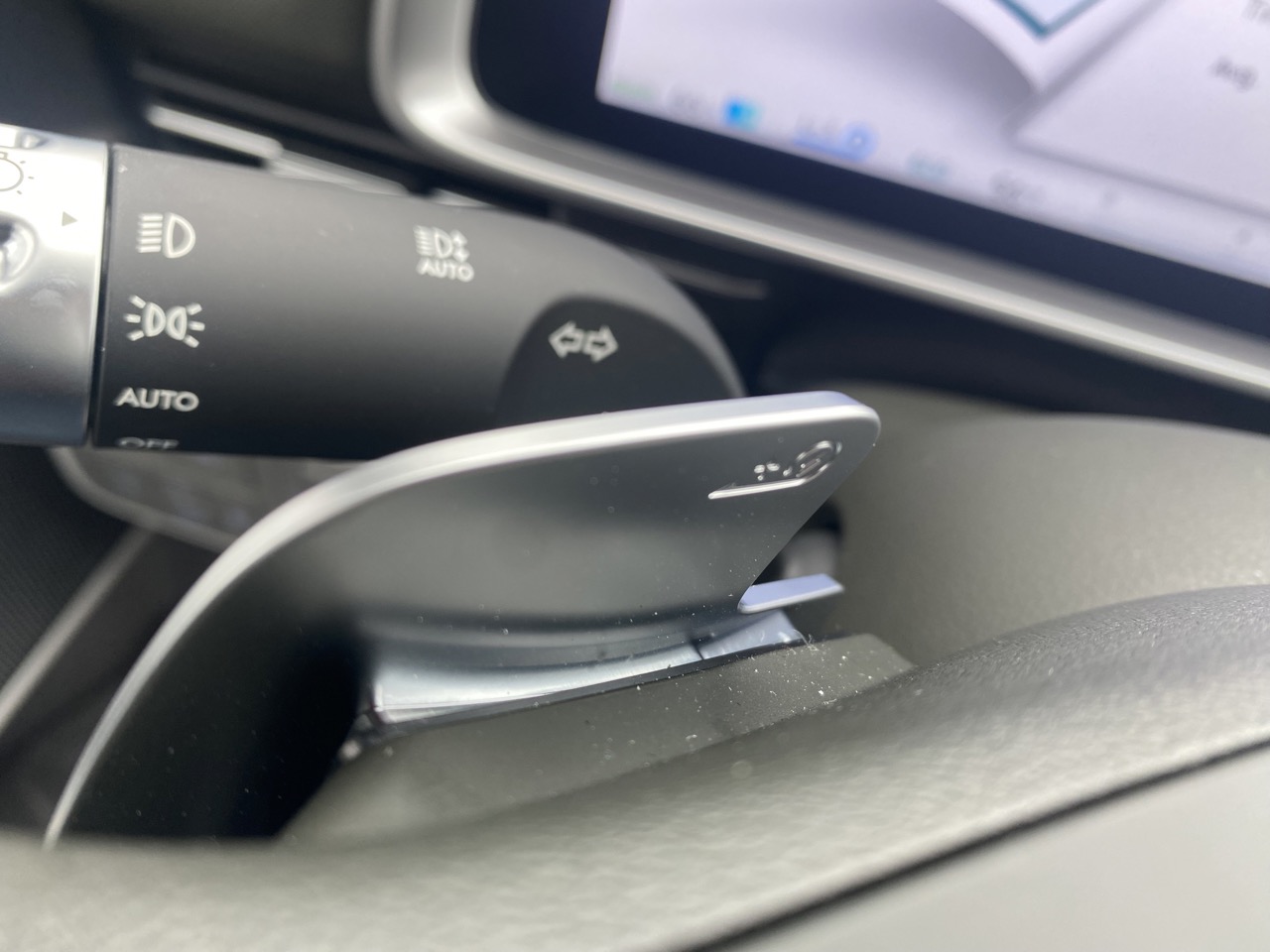
Now, I know what you’re thinking: Jason, you idiot, there are no gears to shift here! And, don’t you hate paddle shifters? Well, not exactly. I think most conventional paddle shifters don’t get used very much, and yes, there aren’t any gears to deal with here. In the case of the Ioniq 6, the paddles adjust the brake regen settings, and I think it works really well.
The Cadillac ELR and the Chevy Volt and the VW Golf Blue e-Motion EV also have paddles that adjusted regen, but I’ll be honest and tell you I do not remember what the experience using those was like. What I do know is that on the Ioniq 6, the paddles can switch the level of electric motor regeneration between five levels, with the most aggressive setting providing one-pedal driving and enough regen to quickly bring the vehicle to a stop, and the other extreme setting allowing for truly freewheeling coasting.

In fact, there’s actually a special dog clutch connected to the front motor unit (when present, of course) that can entirely disconnect the motor from the wheels, which engineers told me can give up to a six percent increase in economy.
What I liked about the paddle regen controls was the ease of adjustment – most other regen systems on EVs I’ve driven have required some sort of screen-and-menu system to adjust these settings – and how that ease encouraged active use of the regen settings to make driving more efficient and engaging. For example, while I still need to actually have an engineer walk me through all the math, there are times when just actually coasting freely is more efficient than using regen to generate electricity to put back into the batteries.
On a long, straight road with a slight downward incline, it just feels better to glide along and coast, and then when you need to slow down, upping the regen is a great way to do that. Sure, there is an onboard auto-adjusting regen system that uses the radar sensors and is likely quite efficient, but I found the active use of the paddles made driving a bit more fun and engaging, so what’s not to like about that?
If you feel like handing off some of the driving duties to the car, you lazy bum, then Hyundai can help, with a Level 2-ish semi-automated driving system called Highway Driving Assist, and the latest version of that can change lanes if you suggest doing so by turning on the proper indicator.
Some Tech Talk
The Ioniq 6 is built on the same E-GMP platform as the Ioniq 5 crossover, the Kia EV6 and the Genesis GV60, all of which are taller vehicles. The use here in a sedan context is an interesting demonstration of the flexibility of the platform. It’s a skateboard-type platform like most other EV platforms, and while the battery pack is in the floor, unlike some other platforms, it isn’t a structural, stressed component. 
I know some may consider this a less elegant way to design EVs, but it should make removal and replacement of the battery pack a less invasive procedure; the engineer I spoke with generally agreed, and that same engineer also described how the lithium-ion cells looked in their modules by describing them as being “like Pop Tarts,” which I found very evocative. There are two of these electric Pop Tart battery packs available, a 480 volt 53 kWh one and a larger 697 volt 77.4 kWh one.
The cooling of the battery pack is handled by serpentine channels of coolant flowing below the battery modules, as opposed to Tesla’s cooling channels, which are more integrated throughout the internal cylindrical cells of the battery pack. In discussing the battery cooling system with an engineer, I was most struck by an interesting reality of electric car engineering: heat is a resource.
In the combustion car world, heat is plentiful, and most of the effort is simply spent trying to expel heat from the system, at least usually. In EVs, there’s a lot less heat to be had, so the heat generated by various systems is carefully monitored and, where possible, routed to places or systems that need the heat, such as batteries for thermal management or such as the cabin, for keeping the people inside from freezing.
I’d never really thought of heat as a precious resource in a car’s powertrain, but it very much can be thought of like that.

Suspension-wise, the Ioniq 6 has MacPherson struts up front and a multi-link setup at the rear. The steering is rack and pinion, and allows for a 38.8 foot turning circle, which felt pretty tight.
Pricing, Options, and Final Thoughts
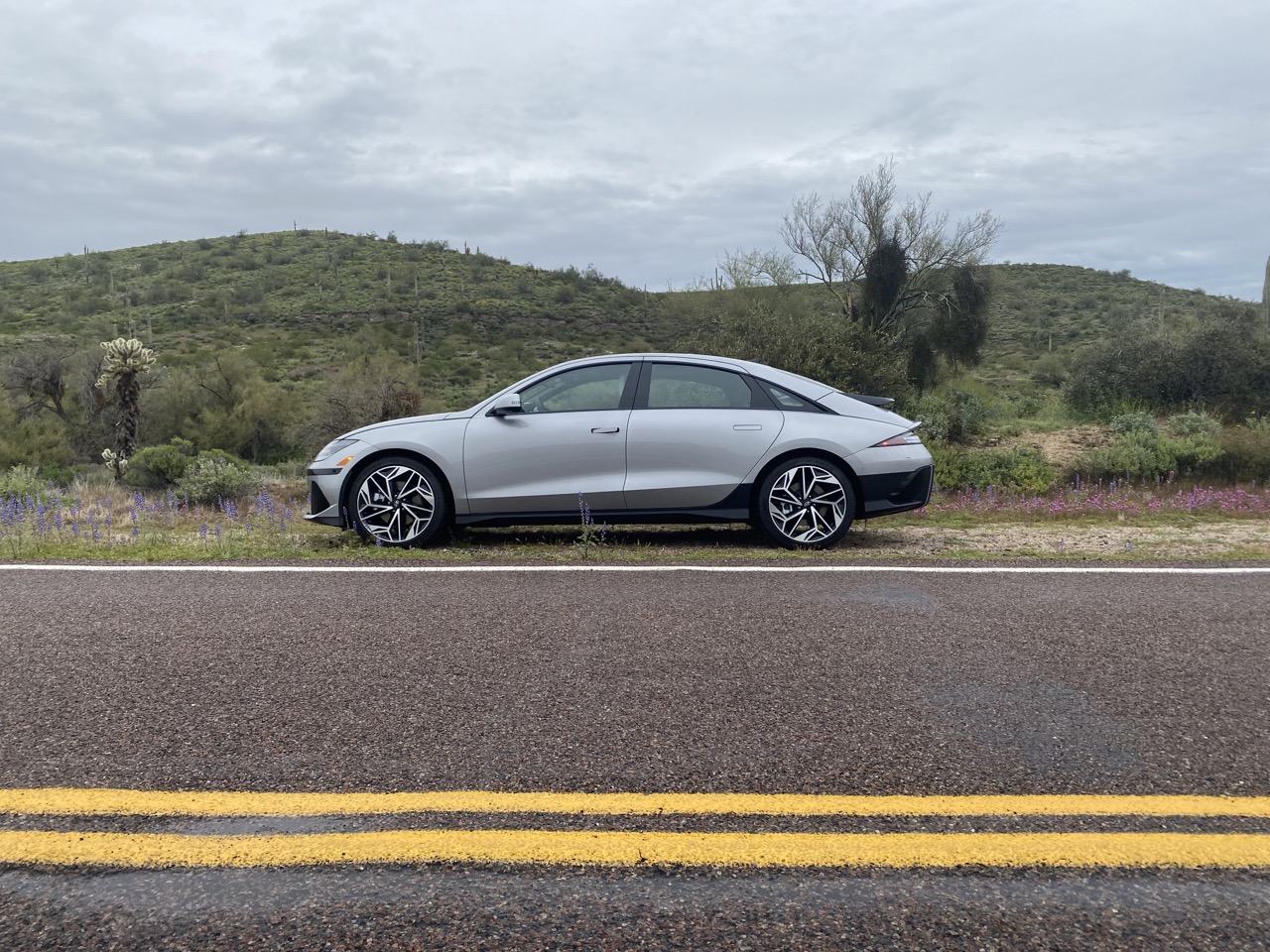
Here are all the ways Hyundai will sell you an Ioniq 6, and how many of your dollars they’ll want in exchange:
| IONIQ 6 Trim Level | Electric Powertrain | Drivetrain | Driving Range | MSRP |
| SE RWD Standard Range (18-inch wheels) | 149HP rear motor | RWD | 240 miles | $41,600 |
| SE RWD Long Range (18-inch wheels) | 225HP rear motor | RWD | 361 miles | $45,500 |
| SE AWD Long Range (18-inch wheels) | 320HP dual motor | AWD | 316 miles | $49,000 |
| SEL RWD (20-inch wheels) | 225HP rear motor | RWD | 305 miles | $47,700 |
| SEL AWD (20-inch wheels) | 320HP dual motor | AWD | 270 miles | $51,200 |
(By the way, this chart can get cut off on mobile, so here it is as a graphic:
For me, I think the sweet spot is the RWD 225 hp one with the 361 mile range for $45,500; that’s really only about average price for a modern car, and a lot less than the average transaction price for an EV, which is almost $60,000. For your money you get a non-boring-looking, comfortable, premium-feeling electric four-door sedan that has a lot of character and a great interior.
The charging network isn’t at the level of Tesla’s Supercharger network, and the Model 3 is a better performer, but there’s something I preferred about the Ioniq 6, and it’s not really something you can quantify. This feels like an optimistic car, and somehow conveys less, I don’t know, arrogance than a car like a Tesla. It has its own very specific style that’s not for everyone, but I suspect that there are plenty of people who will appreciate it, and appreciate it a lot.
Just see if you can get the bigger global market frunk, somehow. We deserve it.

- The Red Bull F1 Team, Rivian, Me: Who Made The Biggest Boneheaded Car-Mistake?
- General Motors Figured Out How To Make A Great Diesel Car Engine Just To Kill It Too Soon
- The Future Of The Auto Industry Is Electric, With A Gasoline Backup
- I’m Attending My First Ever Formula 1 Race And I Have No Idea What To Expect
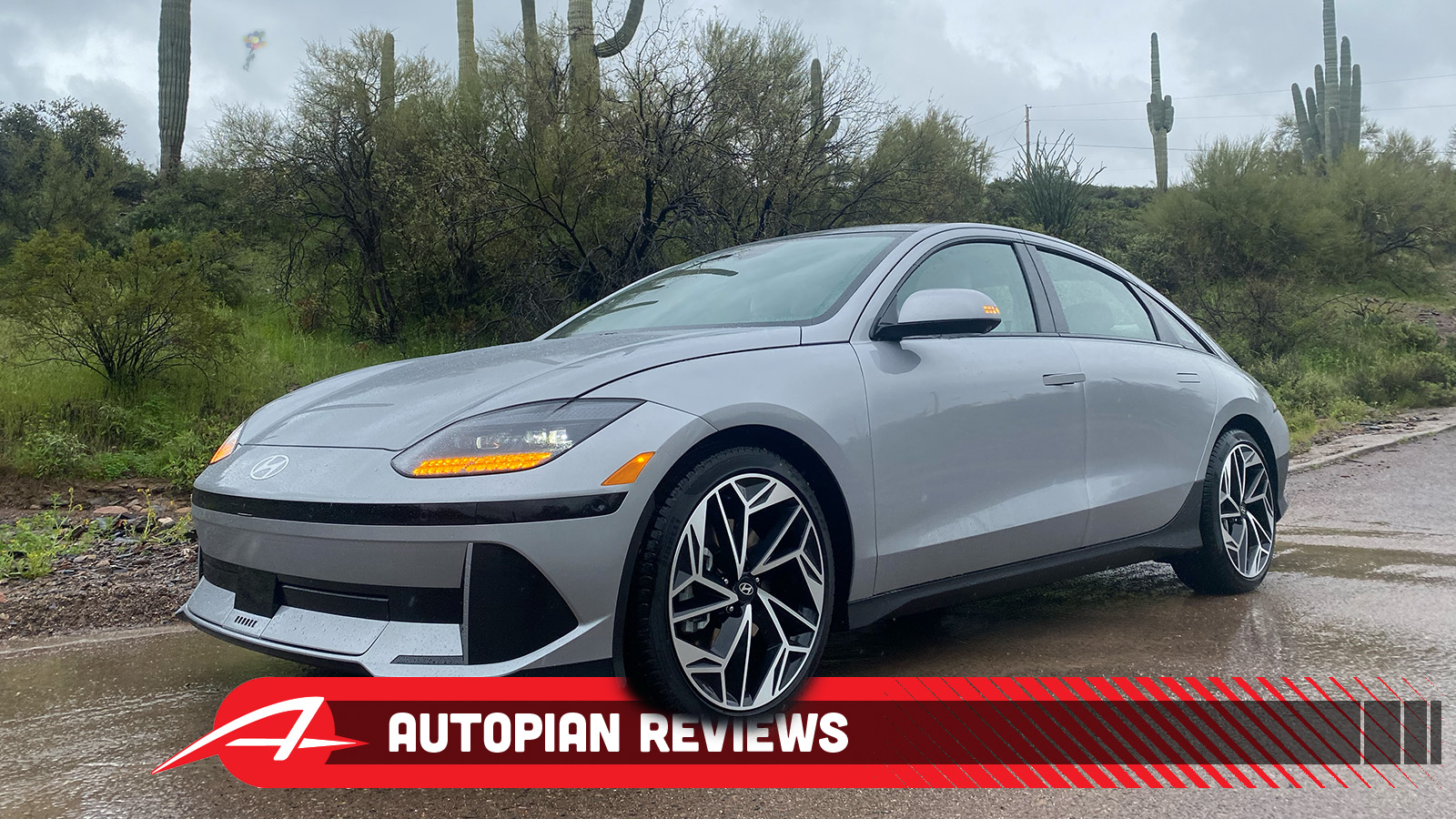




I get that new EVs want to impress with modern and “clean” aesthetic. Why on earth would anyone spend $40+K on a new car with a nearly white interior? You know what is NOT clean? Life, dogs, kids, real actual car use. This interior would look trashed before the second month payment. Automakers: Real colors on the outside, and no piano black or white interiors on the inside.
Needs to be a wagon
I think the Ioniq 5 is essentially the wagon verison.
There’s some seriously top notch writing here.
This is a prime example of the genius of Torch. A good writer would have stood pat on just “drywall” – evocative and somewhat amusing – because it is a small part of a larger thought, and not a particularly important part at that. But a genius writer looks at that and thinks (or, more likely, intuits) that “drywall” doesn’t properly convey the depth of the blandness. It must be “unsalted drywall.” Brilliant.
I just want to say thank you so much for noticing this and being so kind to comment on it! You’re right in that I put drywall, and then looked back at it and thought it needed just a little something more. I’m so incredibly lucky to have readers who not just appreciate what I’m attempting to do but to be so supportive and kind and giving to let me know what is appreciated. And I appreciate that. So, thank you.
This is why I read your articles. I even go back to Colonik on occasion just to reread your Meh Car articles.
I think this site may have covered this in other articles, but it might be worth it to add to this one as well since it is arguably going to be the ‘main’ one for the Ioniq 6: is this car fully or partially eligible for the EV tax credit under the US Inflation Reduction Act?
They’re working on it, from what I’ve heard. The new credit system has to do with where the car was assembled or where the batteries were made. A certain percentage needs to be assembled in the U.S. and they don’t meet requirements for the new system yet. Eligible Models.
My one criticism about the styling of the Ioniq 6 since the teasers has been those overly-fussy wheels.
I’d love to see somebody put the disc-like wheels from the Ioniq 5 on one.
Then, Jason, you showed us that black one with the simpler wheels. I love it.
The Volt (2016+) has a paddle, but it doesn’t adjust regen. It’s just like a way to engage full regen manually, without using the brake pedal. It doesn’t have any gradients, it’s just on or off. I really don’t find myself using it much on my Volt.
I use the transmission lever in my Volt (L mode is half regen, the paddle is full), and it kind of works as a gradient once you’re used to using it a lot.
I used to fiddle with all that a lot more on my 2012 Volt but with my 2017 I find that I just drive it like a normal car, in D, with the brake pedal. I do love L for those long downhill stretches though.
I suspect that one might be able to get their hands on the global market front trunk liner and do a replacement, and that would be an upgrade worth trying, I think.
Thanks for the write-up! I’m so bummed that the Ioniq 6 doesn’t meet my one stupid requirement for next car: the cargo space in the trunk is pathetic. This car was #1 on my list to replace my Volt, which I’m replacing only because we can’t do a weekend away without filling the kid’s foot space with stuff. Great that there’s so much interior space to fit four people, too bad they can’t all bring their stuff along with them.
Yep, trunk is the deal-breaker here. Torch wrote:
But who can do a road trip with 11 cubic feet of cargo space? The smallest Hyundai (Accent sedan) has 13.7 c.f. A VW Beetle – the 1970s version, not the 90s reboot, for heaven’s sake — had 9 cf in its frunk.
I know, I can get the Ioniq 5 if I want more trunk space. But there’s no version of that car with 361 miles of range. So we’re still waiting for the perfect road trip EV.
We got an IONIQ 6 in at work yesterday, and I hopped in this morning to photograph it. If I were in the market for an EV, it would be so very tempting. One of the bigger adjustments would actually be in how it handles regen, coming from my Volt. The Volt has a regular automatic transmission shifter, plus L which is half-power regen, then a paddle you pull on behind the wheel for full regen. I just really like adjusting regen with the transmission lever, and it’d take some doing to adjust to it being fully on wheel paddles.
Anyway – it’s a solid car and I hope it does well, considering how sedans in general fare. Thanks for the thorough review, Jason!
Yay for the Podcast coming back! I’m assuming it’s some sort of hill holder feature, but what is the “auto hold” button for?
One of the few dislikes I have about my E90 is the window switches moving to the door from the center. I also had a Saturn SL2 as a first car with that placement, and with manuals it does work naturally.
Auto hold is a Hyundai thing that you can use to keep the car stopped. I use it at long stop lights or drive-thrus. When you have it on and stop the car, it won’t move if you take your foot off the brake. You just touch the throttle pedal again to get moving. I thought it was the same thing as just putting it in park, but not at all since park unlocks the doors and will often put the parking brake on. I use it fairly often.
Since the AWD versions of EVs always have a huge range hit, why cant it be disabled during dry driving or have some kind of slip sensor that enables AWD mode to save electrons? Is it the added weight that takes a hit? A 45 mile hit seems excessive.
Even if the front motor is disabled, there is still a weight penalty that will affect range.
The weight of a motor is not nearly enough to change the range of an electric vehicle by almost 20%. Something else is going on.
Even adding three passengers and luggage doesn’t change my car’s electric range by that much. The difference is slight enough not to notice in ordinary driving, no more than about 5%.
Thats what I thought as well. My Model 3 runs fulltime AWD, which isn’t efficient. I cant be the first person to consider this, maybe its a cost issue.
The frunk on a Tesla dual motor is the same size as the single motor. The article seemed to insinuate there was a difference. These pizza box frunks are pointless, just skip it.
I just don’t like this cars droopy rear. I prefer the Ioniq 5.
I imagine even a small flat frunk is useful if only to store the charging cable. If the rear trunk is full of actual cargo, then having a cable in a compartment underneath all the other stuff is a hassle.
Ah, I see you’ve experienced the joy of unloading the back of a fully laden station wagon to get at the spare stored under the load floor!
Hey Jason,
Just a quick note. The size of the frunk in a Tesla is the same regardless if it is dual or single motor.
Not my fistful of chili (nice job there). Mostly because the Prophecy concept existed and looked roughly 100x better. I see how they got here, but the result is really lacking imo. Interesting swing and a miss for me from Hyundai, but great write-up from you!
Yeah, maybe if the Prophecy concept hadn’t been designed around approximately 99 inch wheels, the production version with the (correctly) inevitable 18 inch wheels wouldn’t look like it was a Prophecy that fell into the uncanny valley.
Yes, this is Adrian Clarke bait, and no, I still don’t think his defense of the use of enormous wheels in concept design is valid. To be clear: I think Adrian is telling 100% of the truth about *why* they’re used by designers, but I still disagree with the practice because of the inevitable negative impacts they have on the final production vehicle design.
I absolutely hate the idea of screens for the side mirrors. I would not be at all upset if those stayed regulated out of our market.
And it’s my head canon now that the front end is inspired by the second gen Tiburon.
I think it will be a hit. I like it’s looks. As you said, it is not boring. Interior looks nice, but I would never want a light colored interior, so I would go with a different option. I think this price range is the sweet spot for EVs. When you get nice cars for the average price of a new car, adoption rates are going to go up.
I will continue to stand by my comments that Hyundai has become the best possible version of Buick. They typically lean towards a strange mix of comfort, practicality, and style.
Genesis in particular is making the sort of cars that Buick or Olds could be making if they still cared enough to do so(or hadn’t been killed off)
It’s a very good take, and fits with how Kia could be seen as the best version of Pontiac – sporty from the not-to-distant-future.
This has to be the most elaborate car I’ve ever seen come out of Hyundai primarily for all of the design details you pointed out. I can’t say the looks are my cuppa but I can appreciate why it’s done the way it is.
If the range proves to be feasible in real-world application for the price it presents, this would put it at the top of the list if I were in the market for an EV.
There will be no mistaking this car for another. It “works” for the Nissan Murano Convertible and it will work for this Ioniq 6. If I had $52,000 that I wanted to spend on a new car, this would make my list. If range is a big thing, I would think we’d see more battery-powered sedans instead of utility vehicles. What I REALLY want is a Merkur XR4h hybrid with the double spoilers.
Would have made me so happy if Ford surprised-relaunched Merkur as its transitional EV brand. Mach-E would have been soo much cooler as the Scorpio Active or similar.
Would consider if I didn’t have my Model3. That said I’d also miss the Superchargers
Superchargers are going to keep Tesla on top for a while. I am no Musk fan, but I would take a Tesla before any other EV due to ease of charging.
Dunno if I’m in the minority but that is ugly. Like really ugly. I’ll be willing to reevaluate when I see it in 3D versus 2D on a screen.
If the opening paragraphs are meant to frame future car purchases as design driven I’m not sure I’m in agreement. The jump from ICE to EV does make performance a more level playing field in theory but as your quote continues “ride and handling” are differentiators. I’ll posit that utility metrics (range, storage, # of seats, ride height, ingress/egress, etc) are still differentiators that will trump exterior styling for many buyers. This whole site exudes a “what about this cool useful car that looks quirky (ugly?)”
I agree, maybe will get used to though.
The reason that I don’t like the styling of the 6 is because the design language of the 5 and Vision 74 exists. In a vacuum, I like it quite a bit
I finally figured out why I just can’t grow to like this design. It’s more than just a droopy rear end. From the front 3/4 and side views, the car looks like it has larger wheels in the front. I know they’re equal size, but that’s what my brain sees.
wow, I can’t unsee that now. Oddly enough, I like it quite a bit. The beltline swooping down in the rear make it look like the car is leaping forwards. Pretty neat!
I saw a comparatively-rare final iteration Lincoln Continental this weekend, with the slightly more leveled version of this rear end styling. It grows on me the more I see it, I think b/c it stands out from all the tall squared-off hatches of SUV/crossovers.
This review almost makes me want to consider a sedan. I love my Bolt and have no intention of ever returning to a gas car, but sedans typically sit too low for me to comfortably get in and out of them. If this one is truly taller than typical and shows a trend of EV sedans being taller, maybe I can broaden my options when the time comes to replace the Bolt.
Great review/write-up. We just purchased a 2023 Kia Niro EV and it also has the paddle-controlled braking and originally I thought it was odd; however, I often find myself switching between driving Sport and Eco drive modes around town/highways and adjusting brakes at the same time. Fun ride overall (though not enough physical buttons in mine).